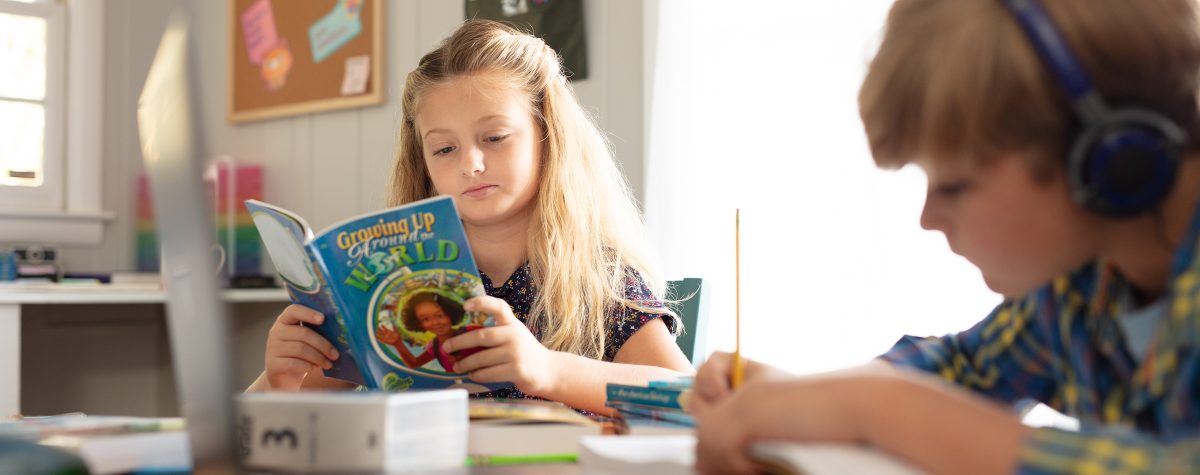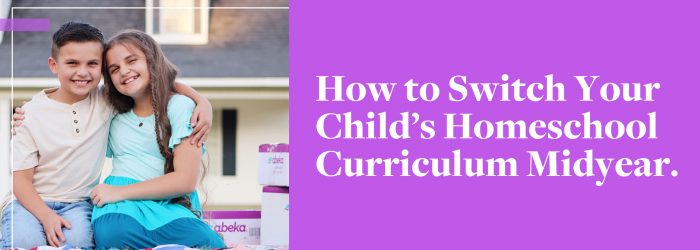By now you know there’s a lot to learn when it comes to homeschool. The flexibility it affords translates into lots of options. Making all of those decisions can quickly become overwhelming. So, while you may have started out the semester doing school one way, you may be looking to switch it up and try something different. And there’s no shame in that!
Homeschool is about finding the right way for your family and your needs, not fitting into someone else’s idea of what school should look like. Whether you started out the year with Abeka’s parent-led approach, our video lessons, or a totally different curriculum altogether, if it’s not working well, it’s not too late to make a change. We’re here to help you navigate how that will work. Let’s start with what to expect if you’re switching to a parent-led approach.
Switching to a Parent-Led Approach
First things first: What does “parent-led” mean? Well, in broad terms, it means you lead the lessons and handle the grading, just like a teacher would. At Abeka, we provide an array of kits for parents to choose from to help guide you through each subject and lesson—we even provide a script if you want to use it.
Moms love these kits because they’re convenient. Rather than tracking down each subject’s individual lesson plan and teacher edition and adding them to your cart, when you purchase an Essential or Complete Parent Kit, all the materials you need for the year are delivered to your door in one convenient box, along with all the quiz and test keys.
Parents who take this approach to homeschool say that it takes them between 3 to 4 hours to complete all their subjects and lessons required in a given day. If you’d like a firsthand look into a day in the life of parent-led homeschool moms, check out how one of our moms of multiples, Kara Cunningham, handles her daily routine in this blog.
If you want to start from scratch and learn everything there is to know about how to get started with homeschooling, this guide to how to start is also very helpful.
Switching to a Video Lesson Approach
If you’ve tried out the parent-led approach and it’s not for you, Abeka Academy video lessons may be a great option to consider. Parents want to be able to do it all, all of the time, but it’s ok if you need a little help. We provide video lessons as an option for our homeschool families because every situation is different and needs change—video lessons are a simple solution for any parent looking to fill the gaps, or even take the reins.
Our video lessons are filmed in real classrooms where real, experienced teachers are leading their students’ lessons. On-screen, students ask questions and interact with the teacher. So from wherever your children are sitting, they will feel as if they’re part of the class too.
Abeka Academy can be done as accredited or as an independent study. The Accredited Program helps parents keep track of their child’s progress by reviewing and grading their work and providing official documents such as report cards, transcripts, and a diploma upon graduation. In some situations, choosing accredited will help you meet state or college-entry requirements more easily. You get to be involved in your child’s learning each day, but you aren’t leading the lessons.
Your second option is Abeka’s Independent Study program. Homeschool families who choose Independent Study through Abeka will still receive all the materials and videos needed to homeschool, but they will have more flexibility over schedules, reports, and deadlines associated with their child’s education.
Outside of the full enrollment of Abeka Academy video lessons, we also offer the flexibility to pick and choose subjects in which you utilize video lessons. That way, if you want to teach the subjects that you’re passionate about (let’s say, Bible and English), you can! And you can leave math and science up to the teachers in the video lessons. It’s all up to you how you choose to customize video lessons to fit your homeschool needs.
If you’re interested in Abeka Academy or our video lessons on demand, you can test them out for yourself right now by trying a week’s worth of lessons for free.
Switching Curriculums Altogether
First things first, do you know which grade your child is prepared for? Once you’ve nailed that down, making a change to a new curriculum will be smooth sailing.
Determine Your Child’s Grade Placement
Grade placement is one of the most important steps in homeschooling. Children who begin behind their grade can catch up! And both those who like the challenge of extra work and those who need more time find success.
First, get a good understanding of what your child learned the previous year. The easiest way to do this is to look at a scope and sequence, which shows how children should be developing academically—what they should be learning and when.
Then look at the publisher’s curriculum for the next grade to determine if your child is ready to enter that grade. Many publishers produce a list of grade-level objectives. If this isn’t available, you can use the table of contents for each student book.
If you plan to use several publishers for different subjects, pay extra attention to your child’s progress and analyze the scope and sequence for each subject and each publisher. Don’t skip this step, because missing foundational concepts will create difficulties for your child.
Scope and Sequence Comparison
If a publisher doesn’t have a scope and sequence, you can also use something similar, like learning objectives with a table of contents.
First, find the publisher’s scope and sequence for the grade just completed. Then find the publisher’s scope and sequence for the upcoming grade. Next, review the learning objectives, concepts, and table of contents for the last grade—one subject at a time—to get familiar with what your child has learned and what he or she can do.
Then look at the publishers’ scope and sequence for the next grade. Compare the scope and sequences for these two grades side by side. Use this side-by-side comparison to assess whether your child has the knowledge and skills he or she needs to be ready for the next grade.
How can you tell? The new grade should build on concepts he or she has already learned. For instance, if the new grade incorporates composition, your child probably wouldn’t be ready for it if he or she hasn’t learned yet how to read and write with comprehension. Everything doesn’t have to be perfectly matched, but you want the basics. There should be some review of concepts from the previous year, and everything new should be a logical next step in learning.
No matter which homeschool option you choose or how many times you switch, with a little trial and error, you can find the right way to homeschool for your family. To learn more about the options available at Abeka, visit our website here.




Comments for How to Switch Up Your Homeschool Curriculum
Add A Comment
Your email address will not be published. Required fields are marked *